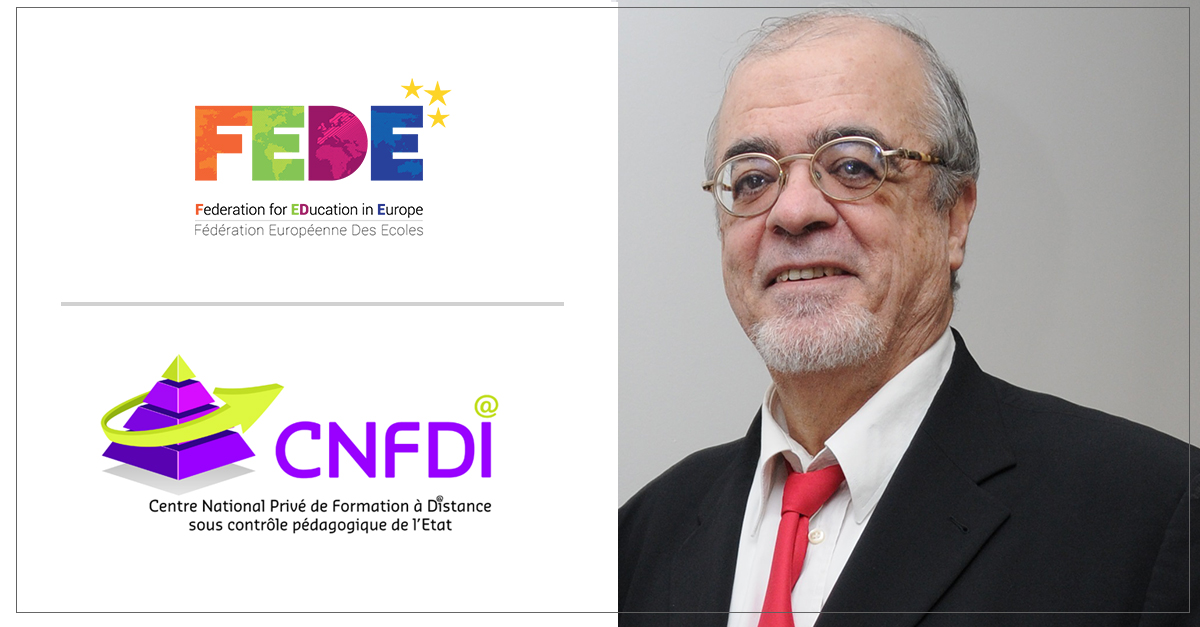Distance learning in 2017: en route to the 4th revolution: by Jean-Pierre Lehnisch – CEO of CNFDI, a FEDE network school.
Distance learning has always been sensitive to the economic, social and psychological environment of the country in which it is practised. From 1850 to 1940, distance learning occupied a minority position in terms of the education system as a whole. However, very rapidly, distance learning had to adapt to the major global events that the world was experiencing. It has been marked by several revolutions. The 4th mutation is heralded and taking shape for 2017.
Jean-Pierre Lehnisch, Ph.D. in Law, a distance learning expert and author of many publications (“Distance learning, law and practice” 1st doctoral thesis on distance learning; “Distance learning” Que sais-je / PUF Collection; “Distance learning and continuing professional development” ESF / Organisation Edition Publishers).
He uses this platform to enlighten us about the development and stakes of distance learning on an international scale.
What caused the first distance learning revolution in the 1940s?
World War II deeply shook the world and Europe in particular where this major cataclysm was born. The school and university realm was certainly not spared from this cataclysm. Pedagogical structures dissolved, schools were occupied, teachers were powerless to attend to their duties, and students were dispersed all over the land and particularly in the countryside which was deemed as being safer. 1st distance learning revolution: adapting by going to the students rather than making them come to schools. As such, correspondence courses greatly developed thanks to patchy postal services.
And during the 30 Glorieuses (The Glorious Thirty)?
Education underwent a 2nd revolution. In the wake of the 1st revolution, eliminating distance learning was out of question, which had been boosted by the circumstances of the war. No, success was such that the public authorities had to maintain and even develop this pedagogical method.
The priority target: the sick, the military (many injured), expatriates and all those who wanted to benefit from the economic development arising from rebuilding efforts to rapidly acquire professional skills.
After 1975, did distance learning become a second-chance school?
The euphoria of the previous years was followed by one economic crisis after the other. Full employment disappeared leading to the emergence of steeper unemployment levels. Breakdown in employment was partly due to those who left the school system without having acquired a profession. “Odd jobs” without any particular skill can provide a certain level of satisfaction during full employment periods as they are certain to be temporary, unlike in difficult economic times where “odd jobs” might end up lasting. Hence, resorting to distance learning in order to gain access to a substantial first job. This concerns rather young students (22-26 years old) and who have not acquired certified professional training.
How does the 4th revolution align with the expanding digital technology?
Development began in 2016. But it will be more significant in 2017 and the ensuing periods. Consequence: emerging new professions and working methods that leave a whole segment of professionals who are already integrated into economic life in complete disarray. How can one advance their level of competence?
By taking evening classes? Very difficult after working during the day and given the distances involved sometimes.
Going for training in person? It is also difficult to leave work for several weeks (or months) to train!
The remaining solution is mixed-pedagogy: distance learning through e-learning and brief periods of attendance in person. Thus, the 4th distance learning revolution! This form of pedagogy needs to satisfy a clientele made up of people who are more mature (30-35 years old), who hold more diplomas (but the basic knowledge soon becomes obsolete) and who are mainly based in the city.
What are the major challenges of distance Learning?
The main challenge facing open distance learning is managing all these revolutions at the same time! Indeed, the goals of the previous revolutions are still relevant and must be met while adapting to the digital changes of the coming years! Its flexibility, dynamics and secular branch that can reach any part of the world enable distance learning to successfully address these challenges. This is the objective of the professionals of this modern form of pedagogy that will ensure that France remains the leading European country in terms of distance learning.
How can distance learning be adapted to a globalised world?
“Globalisation” is not a “dirty word” in terms of distance learning.
The word “globalisation” does not bear a strong appeal in our developed, industrialised societies. It is accused of all evils: falling prices, rising unemployment, a threat to national identity, etc.
We are not talking about that. To the contrary, the word bears promise in terms of open distance learning! No, it is not a “dirty word” in terms of distance learning.
Why?
For 3 essential reasons.
1/ The very purpose of this pedagogical method is to ignore boundaries. All of the current digital relations are working towards eliminating distance. In New Delhi, a student will study the same course as a student living opposite the distance learning school in Paris!
2/ This ease of idea and knowledge circulation is part of the strong belief of seeking equal opportunities for every citizen of the world. Even that person who is not in a favourable geographical environment can study the same course with the same likelihood for success as those who live in a developed country!
3/ What is valid on an individual level is also valid on a macro-sociological level. Emerging countries (China, Africa, South America) are increasingly interested in distance learning as it helps gain knowledge from the source location and to disseminate it on a national scale. This dissemination is even more appreciated as distances to schools are often immense, and budgets are limited and do not allow for establishing structures for attendance in person.
CNFDI also offers its experience to international stakeholders?
Yes. The CNFDI (National Private Centre for Distance Learning) has been sought, within this context, to receive several Chinese and Japanese delegations (television broadcasting directors, universities, lecturers, etc.).
“Globalisation” therefore offers many advantages both to the source countries as well as the recipient countries. This establishes a win-win relationship, not mentioning that it is a rather rare occurrence in the world.
So are “globalisation” and “distance learning” fighting the same fight? Yes, of course![/vc_column_text][/vc_column][vc_column width=”1/3″][vc_empty_space height=”97px”][vc_message message_box_color=”sandy_brown”]The CNFDI (Private National Centre for Distance Learning), which was founded in 1992, has already trained more than 100,000 students in over 100 countries.
The 200 different courses of the CNFDI, all designed for distance learning, enable the learners to train all year round, at their own pace, and in a progressive and personalised manner in 26 sectors of activity.
Supervised by a pedagogical team with professional experience and expertise in distance learning, the learners benefit from effective pedagogical support.
The employment-focused dimension of the training programmes is at the heart of the pedagogical project of the CNFDI, as over 4000 traineeship agreements have been signed. The objective? To prepare men and women to participate actively in working life, switch to other fields or to advance successfully in their careers.
The CNFDI also offers an excellent pedagogical mix comprised of distance learning and internship organised by the centre in collaboration with professionals.
More informations about CNFDI

